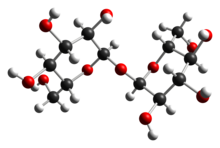
Back تريهالوز Arabic ترهالوز AZB Трэгалоза Byelorussian Trehalosa Catalan Trehalóza Czech Trehalose German Τρεχαλόζη Greek Trehalosa Spanish Trehalosa Basque ترهالوز Persian

| |

| |

| |
| Names | |
|---|---|
| IUPAC name
α-D-glucopyranosyl-(1→1)-α-D-glucopyranoside
| |
| Systematic IUPAC name
(2R,3S,4S,5R,6R)-2-(Hydroxymethyl)-6-[(2R,3R,4S,5S,6R)-3,4,
5-trihydroxy-6-(hydroxymethyl)oxan-2-yl]oxyoxane-3,4,5-triol | |
| Other names
α,α‐Trehalose
| |
| Identifiers | |
3D model (JSmol)
|
|
| ChEBI | |
| ChEMBL | |
| ChemSpider | |
| ECHA InfoCard | 100.002.490 |
PubChem CID
|
|
| UNII | |
CompTox Dashboard (EPA)
|
|
| |
| |
| Properties | |
| C12H22O11 (anhydride) | |
| Molar mass | 342.296 g/mol (anhydrous) 378.33 g/mol (dihydrate) |
| Appearance | White orthorhombic crystals |
| Density | 1.58 g/cm3 at 24 °C |
| Melting point | 203 °C (397 °F; 476 K) (anhydrous) 97 °C (dihydrate) |
| 68.9 g per 100 g at 20 °C[1] | |
| Solubility | Slightly soluble in ethanol, insoluble in diethyl ether and benzene[2] |
Except where otherwise noted, data are given for materials in their standard state (at 25 °C [77 °F], 100 kPa).
| |
Trehalose (from Turkish tıgala – a sugar derived from insect cocoons + -ose)[3] is a sugar consisting of two molecules of glucose. It is also known as mycose or tremalose. Some bacteria, fungi, plants and invertebrate animals synthesize it as a source of energy, and to survive freezing and lack of water.
Extracting trehalose was once a difficult and costly process, but around 2000, the Hayashibara company (Okayama, Japan) discovered an inexpensive extraction technology from starch.[4][5] Trehalose has high water retention capabilities, and is used in food, cosmetics and as a drug. A procedure developed in 2017 using trehalose allows sperm storage at room temperatures.[6]
- ^ Higashiyama T (2002). "Novel functions and applications of trehalose" (PDF). Pure Appl. Chem. 74 (7): 1263–1269. doi:10.1351/pac200274071263. S2CID 28311022.
- ^ Lide, David R. (1998). Handbook of Chemistry and Physics (87 ed.). Boca Raton, Florida: CRC Press. pp. 3–534. ISBN 978-0-8493-0594-8.
- ^ "Trehalose | Definition of Trehalose by Lexico". Archived from the original on February 26, 2022.
- ^ Cargill, Incorporated (30 May 2011). "Cargill, Hayashibara to Introduce Trehalose Sweetener to the Americas". PR Newswire. Retrieved 2011-07-31.
- ^ "JAPAN: Cargill, Hayashibara to Introduce Trehalose Sweetener to the Americas". just-food.com. 2000-05-31. Retrieved 2 February 2013.
- ^ Patrick, Jennifer L.; Elliott, Gloria D.; Comizzoli, Pierre (1 November 2017). "Structural integrity and developmental potential of spermatozoa following microwave-assisted drying in the domestic cat model". Theriogenology. 103: 36–43. doi:10.1016/j.theriogenology.2017.07.037. PMID 28772113.